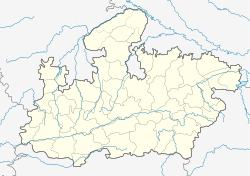Dharanagar
|
Dhar Dhara |
|
|---|---|
| city | |
| Coordinates: 22°35′53″N 75°18′14″E / 22.598°N 75.304°ECoordinates: 22°35′53″N 75°18′14″E / 22.598°N 75.304°E | |
| Country | India |
| State | Madhya Pradesh |
| District | Dhar |
| Elevation | 559 m (1,834 ft) |
| Population (2011) | |
| • Total | 93,917 |
| Languages | |
| • Official | Hindi |
| Time zone | IST (UTC+5:30) |
| Vehicle registration | MP 11 |
| Website | www |
Dhar (Hindi: धार) is a city located in the Malwa region of western Madhya Pradesh state in central India. It is the administrative headquarters of Dhar District, and was the capital of the Rajput Dhar State as Dharanagar from 1732 (previously the Raja had his seat at Multhan from 1728).
Lying between 21°57' and 23°15' north, and 74°37' and 75°37' east. Bordered on the north by Ratlam; east by parts of Gwalior and Indore; on the south by Barwani, and on the west by Jhabua and portions of Gwalior and Indore. The town is located 33 miles (53 km) west of Mhow, 559 m (1,834 ft) above sea level. It is picturesquely situated among lakes and trees surrounded by barren hills, and possesses, besides its old ramparts, many interesting buildings, some of them containing records of cultural, historical and national importance.
The most ancient parts of Dhār visible are the massive earthen ramparts which are best preserved on the western and southern sides of the town. These were probably built beginning in the ninth century and show that the city was circular in plan and surrounded by a series of tanks and moats. The layout is similar to the circular city of Warangal in the Deccan. The circular ramparts of Dhār, unique in north India and an important legacy of the Paramāras, is being destroyed by brick-makers and others using the material for construction purposes. On the north-east side of the town, the rampart and moat have disappeared beneath modern homes and other buildings.
The historic parts of the town are dominated by an impressive sandstone fortress on a small hill. It is thought to have been built by Muhammad bin Tughluq, the Sultan of Delhi, probably on the site of the ancient Dhārāgiri mentioned in early sources. One of the gateways, added at a later time, dates to 1684-85 in the time of 'Ālamgīr. Inside the fort is a deep rock-cut cistern, of great age, and a later palace of the Mahārāja of Dhār incorporating an elegant pillared porch of the Mughal period that probably belongs to the mid-seventeenth century. In the palace area is an outdoor museum with a small collection of temple fragments and images dating to medieval times.
...
Wikipedia

